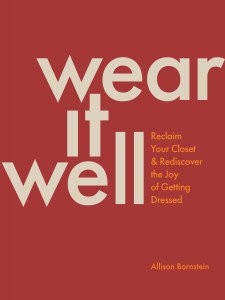If your TikTok feed has picked up on an even small interest in personal style, you’ve likely heard of the “three word method.” Used for years by stylist Allison Bornstein during personal styling sessions with clients as a way to help people home in on their own style, Bornstein’s concept took off in the last year thanks to TikTok, making her a social media fixture in the process.
Now, Bornstein has brought her “three word method” and much more to print with the release of her first book, “Wear It Well: Reclaim Your Closet and Rediscover the Joy of Getting Dressed.”
Bornstein had been working with clients over FaceTime during the pandemic, sorting out their needs of dressing while largely at home, when she got the idea for a book.
“I was talking to my cousin one night about it — I was staying at her house upstate and she was like, ‘tell me about everyone today. What was their issue? What did you talk about? Where do they live?’ And I was realizing as I was talking to her that while obviously we all have our unique set of wardrobe issues and traumas and things that we’re trying to work out, a lot of what we want and what we need and the information that we’re seeking is kind of the same,” Bornstein says. “So I was thinking, OK, of course I can continue doing my styling sessions, which I will, and doing hand-to-hand direct advice. But I felt that there was so much that felt really universal. So I wanted to make a book to just help people get dressed and enjoy it.”
Bornstein, who previously assisted celebrity stylists before going out on her own, approaches personal styling in a three-pronged manner. The first is about bringing joy to getting dressed, an exercise that for many has become complicated, she says.
“I feel like as women, getting dressed isn’t necessarily framed as something that’s creative and fun and joyful. Instead, it can be very much tied up with body image and status,” Bornstein says. “And there’s a lot there when it comes to clothing.”
She also helps people think around the idea that style is something you either have or don’t, and rather works with them to embrace whatever their own personal style is. A big part of that is recognizing that you don’t need to go out and buy a whole new wardrobe once you identify your look.

“Wear It Well” by Allison Bornstein.
Courtesy
“People are over-consuming and shopping so much, but having very little sense or understanding of what they own. I felt like oftentimes we would go in somebody’s closet and the first thing they would say to me was ‘I have no clothes. I hate my wardrobe. I just want to start fresh.’ And then by the end of the session, they’re like, ‘oh, I actually have some really cute stuff here,’” Bornstein says. “Everybody has style, and it’s just a matter of finding it and figuring out what it is. And it’s not supposed to all be the same, and it’s not supposed to be copy paste on what’s trendier, what all the influences are wearing. It’s supposed to be genuine and it’s supposed to express who you are.”
The FIT grad got her start in the industry with an internship at Teen Vogue before moving into celebrity styling, and left New York a year ago for Los Angeles. While working in fashion, she’s noticed her personal interest is less in what’s coming down the runways and more what she sees on people on the street.
“I remember even just during fashion week when I would go to shows, I was so much more interested in what the street style was as opposed to what was coming down the runway,” Bornstein says. “That was where I discovered my passion, and then I started working with clients and helping them curate a wardrobe as opposed to curating looks.”
“Wear it Well,” which took Bornstein two years to actualize, is intended to have a timeless feel, rather than something on specific of-the-moment trends.
“I wanted it to feel where you could be at your friend’s house, you could be waiting for your friend to get dressed before you could go to dinner, and you could pick it up and go to any page and read something and be like, ‘oh, interesting,” Bornstein says. “I wanted it to feel rich with information. And of course you can read it cover to cover, but I wanted it to feel like interesting tidbits that you could just kind of pick up.”
This post was originally published on this site be sure to check out more of their content.








